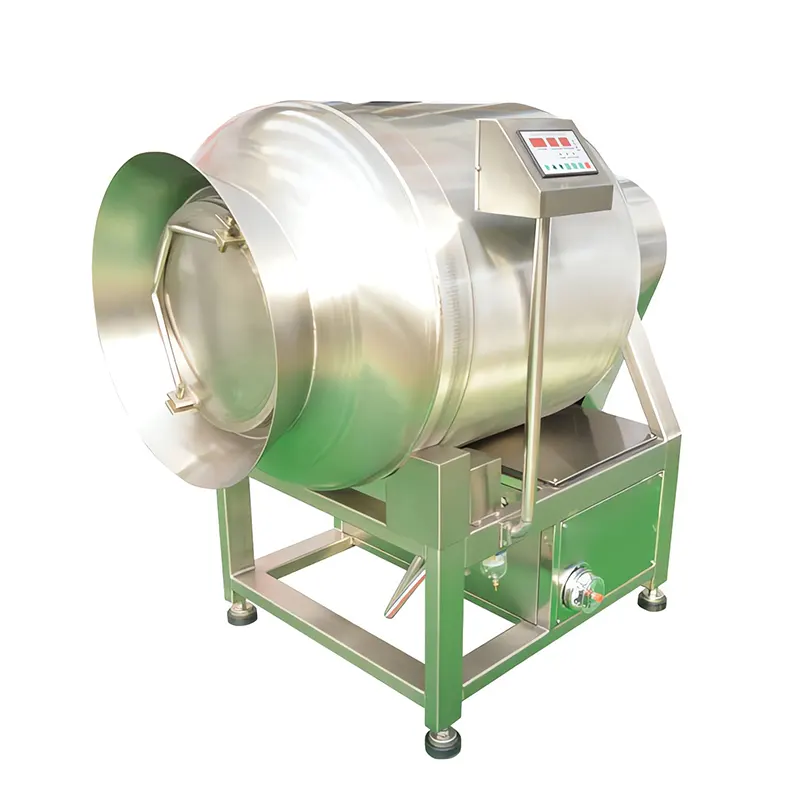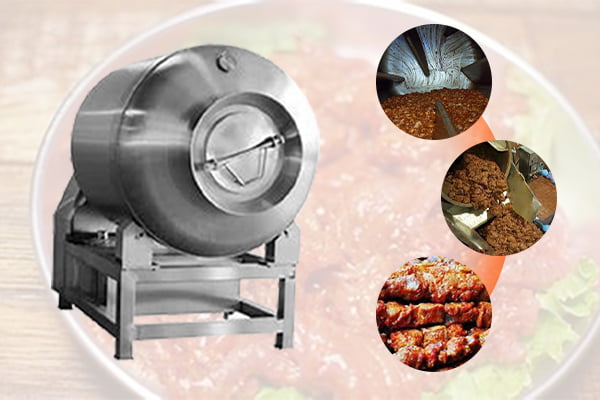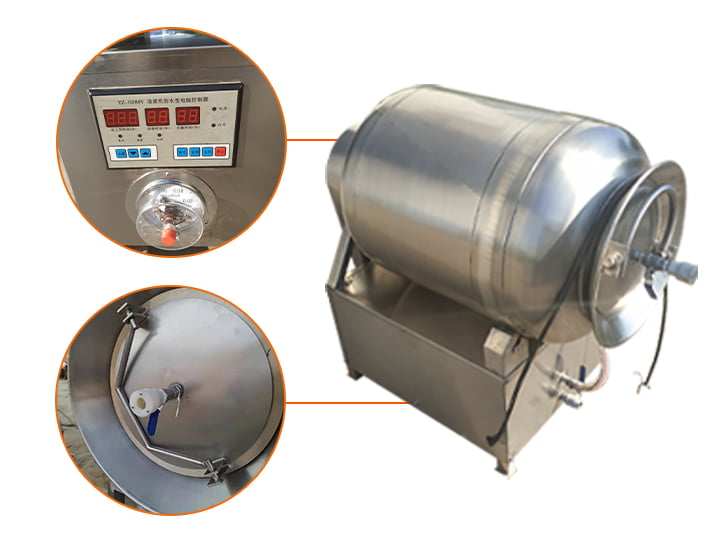10 years of experience as a food machinery equipment manufacturer
10 years of experience as a food machinery equipment manufacturer
Meat processing advancements consistently focus on enhancing product quality, consistency, and overall yield. Within this pursuit, mechanical marination and treatment methods such as tumbling and roll kneading have become vital. These physical processes are engineered to improve the intrinsic characteristics of meat products, primarily by facilitating the more efficient absorption of marinades, tenderizing muscle fibers, and encouraging the extraction of functional proteins. Such methods represent a significant improvement over traditional techniques, which often involved lengthy soaking periods or manual manipulation, leading to inconsistencies and higher labor costs.

A vacuum tumbler roll kneading machine is a sophisticated piece of equipment designed specifically for the rigorous demands of the meat processing industry. Its core function is to combine controlled mechanical action with a sub-atmospheric (vacuum) environment to optimize the treatment of various meat cuts. These machines typically feature a rotating drum wherein the meat is processed, integrated systems to create and precisely maintain a vacuum, and sophisticated controls to manage the diverse parameters of the processing cycle.
The application of vacuum during the tumbling and roll kneading process offers several distinct and measurable advantages that contribute to a superior end product.
Improved Marinade Absorption: Under vacuum conditions, air pockets within the meat’s interstitial spaces and surface pores are effectively evacuated. This evacuation creates a significant pressure differential. When the vacuum is subsequently released, or even during the dynamic tumbling action under vacuum, this differential facilitates a more rapid, deeper, and uniform penetration of marinades, brines, or curing agents directly into the muscle tissue. This ensures a consistent distribution of flavors and other functional ingredients throughout the meat.
Enhanced Tenderization: The mechanical impact experienced by the meat pieces as they fall against each other and the internal surfaces of the drum contributes significantly to tenderization. This action is often augmented by strategically placed internal baffles or flights within the drum. These components help to break down tough muscle fibers and resilient connective tissues. The vacuum environment can further contribute by causing muscle fibers to expand slightly, making them more susceptible to this mechanical tenderization, ultimately resulting in a more tender final product.
Increased Yield: By promoting superior absorption and subsequent retention of moisture and marinade components, vacuum tumbling can markedly increase the overall product yield. Processors often observe reduced purge (moisture loss) during storage and diminished cooking loss, which translates directly into tangible economic benefits. Furthermore, the extracted proteins form a gel-like matrix that helps to bind water within the meat structure.
Improved Product Consistency: The ability to automate and precisely control parameters such as tumbling time, rotational speed, designated rest periods, and vacuum levels ensures that each batch of meat is processed under virtually identical conditions. This meticulous control leads to greater uniformity in terms of flavor profile, tenderness, color development, and overall perceived quality, which is critical for maintaining brand reputation and satisfying consumer expectations.
Enhanced Protein Extraction: The combination of mechanical action under vacuum is highly effective in extracting salt-soluble proteins, primarily myosin and actin, from the muscle cells and bringing them to the surface of the meat pieces. These proteins become sticky and tacky upon extraction, which is essential for binding meat pieces together in the production of restructured products like hams or certain types of sausages. This also improves sliceability and overall texture.
Reduced Processing Time: When compared to traditional static marination techniques, which can require many hours or even extend over several days, vacuum tumbling can achieve comparable or often superior results in a significantly shorter timeframe. This reduction, often to a matter of hours or even minutes for specific applications, greatly increases production throughput and overall operational efficiency.
Better Color Development and Stability: For cured meat products, the uniform distribution of curing agents such as nitrites is vital for consistent and appealing color development. Vacuum tumbling aids this even distribution. Additionally, the vacuum environment can contribute to a more stable and attractive color in the final product by minimizing oxidative processes that can lead to discoloration.
The term “roll kneading” often emphasizes a specific type or a refinement of the mechanical action that occurs within the tumbler. While basic tumbling primarily involves the lifting and dropping of meat, roll kneading suggests a more gentle yet thoroughly effective massaging or working of the meat. This action aims to replicate the beneficial effects of manual kneading, ensuring that the marinade is not just superficially applied but is actively worked into the deep muscle structure. The design of the drum and its internal flights or paddles is frequently optimized to achieve this specific kneading motion. This can be particularly advantageous for more delicate meat products where overly aggressive tumbling might cause excessive structural damage, or for applications requiring maximum protein extraction without shredding the meat. The kneading action effectively helps to expose more muscle surface area for protein extraction and marinade contact, leading to a more homogenous product with significantly improved binding characteristics. It represents a carefully engineered balance between effective processing and maintaining the structural integrity of the meat.

Understanding the core components of a typical vacuum tumbler roll kneading machine provides valuable insight into its operational capabilities and the science behind its effectiveness.
Vacuum tumbler roll kneading machines are remarkably versatile and find extensive application across a wide spectrum of meat, poultry, and even some seafood products.
Whole Muscle Meats: This is a primary and highly significant application area. Products such as various types of hams (cooked, cured, smoked), bacon bellies, corned beef, pastrami, and different roasts benefit considerably from the tumbling process. The technology ensures deep and uniform penetration of curing agents and flavors, improves tenderness substantially, and often increases final product yield. For poultry, items like chicken breasts, turkey roasts, and marinated chicken portions are commonly processed using these machines to enhance juiciness and flavor uptake.
Restructured and Reformed Meats: For products that are manufactured from smaller pieces of meat which need to bind together effectively—such as certain types of deli meats, poultry nuggets, or reformed steaks—the protein extraction facilitated by tumbling is absolutely crucial. The tacky protein exudate formed during the process acts as a natural binder, significantly improving the texture and sliceability of the product after cooking.
Sausage Production: While not universally employed for all types of sausage, tumbling can be effectively used in the pre-processing stages for certain varieties. It can aid in the even distribution of cure ingredients and the extraction of binding proteins in coarse-ground sausages before final grinding and stuffing, thereby contributing to better bind, texture, and overall product integrity.
Jerky and Dried Meats: The process of marinating strips of meat for jerky production can be notably accelerated and made more uniform through the use of a vacuum tumbler. This ensures consistent flavor throughout the product and can also aid in the initial stages of the moisture removal process critical for jerky.
Seafood Processing: Although less common than in red meat and poultry processing, smaller, more delicately operating tumblers can be used for marinating certain types of fish fillets or shellfish. For these applications, a gentle action is paramount to avoid damaging the delicate structure of the seafood product while still achieving the benefits of enhanced marinade penetration.
The inherent adaptability of these machines, particularly those equipped with programmable controls, allows processors to meticulously tailor processing cycles for specific product types, unique ingredient formulations, and desired end-product characteristics.
Choosing the most suitable vacuum tumbler roll kneading machine is a significant capital investment for any meat processing facility. Several critical factors should be carefully evaluated to ensure the selected equipment meets both current and future operational needs.

